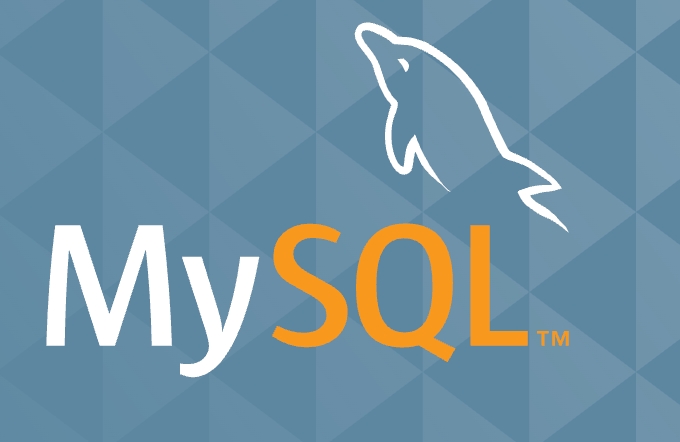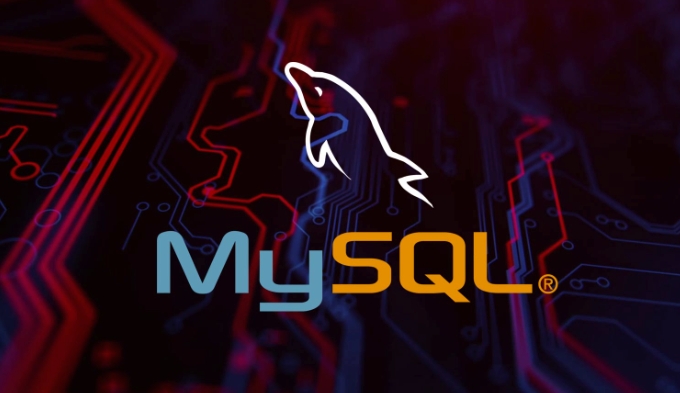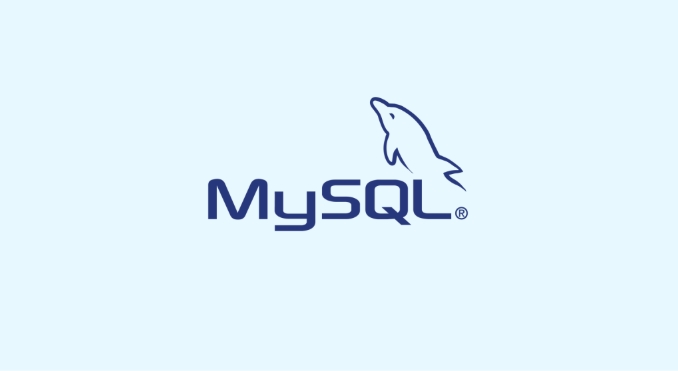When "Error 2002: Can't connect to local MySQL server through socket '/tmp/mysql.sock'" appears, 1. First confirm whether MySQL is started, use brew services list to check the status, and if stopped, use brew services start mysql to start the service; 2. Check whether the connection method is correct, try to change the host from localhost to 127.0.0.1; 3. Confirm whether the sock file path is consistent, check whether /tmp/mysql.sock exists or check the path settings in the configuration file; 4. Troubleshoot permissions or port occupancy issues, check whether port 3306 is occupied and ensure that the data directory has correct read and write permissions.

This problem is quite common when using MySQL on Mac, especially for some friends who are new to development environments. The prompt like "Error 2002: Can't connect to local MySQL server through socket '/tmp/mysql.sock'" appears, and the basic meaning is that your program or command cannot find the running MySQL service.

Below I will talk about how to troubleshoot and solve this problem from several common perspectives.

1. Confirm whether MySQL has been started
This is one of the most common reasons: MySQL is not running .
You can enter the following command through the terminal to view the status of MySQL:

brew services list | grep mysql
If you see stopped , it means that the service is not running. You need to start it manually:
brew services start mysql
If you are using a native installation method (such as the official DMG installation package), you can find MySQL in the system preference settings and click "Start MySQL Server".
Tips: Sometimes, although you have started MySQL before, the service will stop after restarting the computer. Remember to check it.
2. Check whether the connection method is correct
Sometimes you use localhost , but in fact, MySQL configuration listens for 127.0.0.1 , or vice versa.
- When using
localhostconnection, MySQL defaults to Unix sockets (that is,/tmp/mysql.sock). - When using the
127.0.0.1connection, the TCP/IP protocol is adopted.
If you are facing the problem that the sock file cannot be found, you can try changing the connection address from localhost to 127.0.0.1 to see if you can connect.
For example, when configuring database connections in PHP, Python, or other languages, modify them as follows:
# Put this: host="localhost" # Change to: host="127.0.0.1"
3. Sock file paths are inconsistent
Another possible reason is: The path of the sock file actually generated by MySQL is different from the location you expect .
You can open MySQL configuration file (usually /usr/local/etc/my.cnf or /etc/my.cnf ) and find content similar to this line:
socket = /tmp/mysql.sock
Then check if there is any actual sock file under this path:
ls -l /tmp/mysql.sock
If not, it may be that MySQL startup failed, or another path was written. You can try restarting MySQL and observing the log:
brew services restart mysql
The log is usually in /usr/local/var/log/mysql/error.log to see if there is any error message.
4. Properties or ports occupied (rare but worth a look)
Sometimes MySQL startup fails because of incorrect permissions or the port being occupied.
- Check port occupancy:
lsof -i:3306
If a process occupies port 3306, you can consider killing it and restarting MySQL.
- Check the MySQL data directory permissions (usually in
/usr/local/var/mysql/) to ensure that the current user has read and write permissions.
Basically these common reasons.
It's not particularly complicated, but it's easy to get stuck for a long time because of a small place.
When encountering this error, first confirm whether the service is running, then check the connection method and sock file path, which can be done in most cases.
The above is the detailed content of error 2002 can't connect to local mysql server on mac. For more information, please follow other related articles on the PHP Chinese website!

Hot AI Tools

Undress AI Tool
Undress images for free

Undresser.AI Undress
AI-powered app for creating realistic nude photos

AI Clothes Remover
Online AI tool for removing clothes from photos.

Clothoff.io
AI clothes remover

Video Face Swap
Swap faces in any video effortlessly with our completely free AI face swap tool!

Hot Article

Hot Tools

Notepad++7.3.1
Easy-to-use and free code editor

SublimeText3 Chinese version
Chinese version, very easy to use

Zend Studio 13.0.1
Powerful PHP integrated development environment

Dreamweaver CS6
Visual web development tools

SublimeText3 Mac version
God-level code editing software (SublimeText3)
 Handling NULL Values in MySQL Columns and Queries
Jul 05, 2025 am 02:46 AM
Handling NULL Values in MySQL Columns and Queries
Jul 05, 2025 am 02:46 AM
When handling NULL values ??in MySQL, please note: 1. When designing the table, the key fields are set to NOTNULL, and optional fields are allowed NULL; 2. ISNULL or ISNOTNULL must be used with = or !=; 3. IFNULL or COALESCE functions can be used to replace the display default values; 4. Be cautious when using NULL values ??directly when inserting or updating, and pay attention to the data source and ORM framework processing methods. NULL represents an unknown value and does not equal any value, including itself. Therefore, be careful when querying, counting, and connecting tables to avoid missing data or logical errors. Rational use of functions and constraints can effectively reduce interference caused by NULL.
 Performing logical backups using mysqldump in MySQL
Jul 06, 2025 am 02:55 AM
Performing logical backups using mysqldump in MySQL
Jul 06, 2025 am 02:55 AM
mysqldump is a common tool for performing logical backups of MySQL databases. It generates SQL files containing CREATE and INSERT statements to rebuild the database. 1. It does not back up the original file, but converts the database structure and content into portable SQL commands; 2. It is suitable for small databases or selective recovery, and is not suitable for fast recovery of TB-level data; 3. Common options include --single-transaction, --databases, --all-databases, --routines, etc.; 4. Use mysql command to import during recovery, and can turn off foreign key checks to improve speed; 5. It is recommended to test backup regularly, use compression, and automatic adjustment.
 Calculating Database and Table Sizes in MySQL
Jul 06, 2025 am 02:41 AM
Calculating Database and Table Sizes in MySQL
Jul 06, 2025 am 02:41 AM
To view the size of the MySQL database and table, you can query the information_schema directly or use the command line tool. 1. Check the entire database size: Execute the SQL statement SELECTtable_schemaAS'Database',SUM(data_length index_length)/1024/1024AS'Size(MB)'FROMinformation_schema.tablesGROUPBYtable_schema; you can get the total size of all databases, or add WHERE conditions to limit the specific database; 2. Check the single table size: use SELECTta
 Aggregating data with GROUP BY and HAVING clauses in MySQL
Jul 05, 2025 am 02:42 AM
Aggregating data with GROUP BY and HAVING clauses in MySQL
Jul 05, 2025 am 02:42 AM
GROUPBY is used to group data by field and perform aggregation operations, and HAVING is used to filter the results after grouping. For example, using GROUPBYcustomer_id can calculate the total consumption amount of each customer; using HAVING can filter out customers with a total consumption of more than 1,000. The non-aggregated fields after SELECT must appear in GROUPBY, and HAVING can be conditionally filtered using an alias or original expressions. Common techniques include counting the number of each group, grouping multiple fields, and filtering with multiple conditions.
 Handling character sets and collations issues in MySQL
Jul 08, 2025 am 02:51 AM
Handling character sets and collations issues in MySQL
Jul 08, 2025 am 02:51 AM
Character set and sorting rules issues are common when cross-platform migration or multi-person development, resulting in garbled code or inconsistent query. There are three core solutions: First, check and unify the character set of database, table, and fields to utf8mb4, view through SHOWCREATEDATABASE/TABLE, and modify it with ALTER statement; second, specify the utf8mb4 character set when the client connects, and set it in connection parameters or execute SETNAMES; third, select the sorting rules reasonably, and recommend using utf8mb4_unicode_ci to ensure the accuracy of comparison and sorting, and specify or modify it through ALTER when building the library and table.
 Implementing Transactions and Understanding ACID Properties in MySQL
Jul 08, 2025 am 02:50 AM
Implementing Transactions and Understanding ACID Properties in MySQL
Jul 08, 2025 am 02:50 AM
MySQL supports transaction processing, and uses the InnoDB storage engine to ensure data consistency and integrity. 1. Transactions are a set of SQL operations, either all succeed or all fail to roll back; 2. ACID attributes include atomicity, consistency, isolation and persistence; 3. The statements that manually control transactions are STARTTRANSACTION, COMMIT and ROLLBACK; 4. The four isolation levels include read not committed, read submitted, repeatable read and serialization; 5. Use transactions correctly to avoid long-term operation, turn off automatic commits, and reasonably handle locks and exceptions. Through these mechanisms, MySQL can achieve high reliability and concurrent control.
 Connecting to MySQL Database Using the Command Line Client
Jul 07, 2025 am 01:50 AM
Connecting to MySQL Database Using the Command Line Client
Jul 07, 2025 am 01:50 AM
The most direct way to connect to MySQL database is to use the command line client. First enter the mysql-u username -p and enter the password correctly to enter the interactive interface; if you connect to the remote database, you need to add the -h parameter to specify the host address. Secondly, you can directly switch to a specific database or execute SQL files when logging in, such as mysql-u username-p database name or mysql-u username-p database name
 Managing Character Sets and Collations in MySQL
Jul 07, 2025 am 01:41 AM
Managing Character Sets and Collations in MySQL
Jul 07, 2025 am 01:41 AM
The setting of character sets and collation rules in MySQL is crucial, affecting data storage, query efficiency and consistency. First, the character set determines the storable character range, such as utf8mb4 supports Chinese and emojis; the sorting rules control the character comparison method, such as utf8mb4_unicode_ci is case-sensitive, and utf8mb4_bin is binary comparison. Secondly, the character set can be set at multiple levels of server, database, table, and column. It is recommended to use utf8mb4 and utf8mb4_unicode_ci in a unified manner to avoid conflicts. Furthermore, the garbled code problem is often caused by inconsistent character sets of connections, storage or program terminals, and needs to be checked layer by layer and set uniformly. In addition, character sets should be specified when exporting and importing to prevent conversion errors






